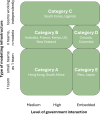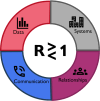How does policy modelling work in practice? A global analysis on the use of epidemiological modelling in health crises
- PMID: 40478854
- PMCID: PMC12143527
- DOI: 10.1371/journal.pgph.0004675
How does policy modelling work in practice? A global analysis on the use of epidemiological modelling in health crises
Abstract
This study examines the use and translation of epidemiological modelling by policy and decision makers in response to the COVID-19 outbreak. Prior to COVID-19, there was little readiness for global health systems, and many science-policy networks were assembled ad-hoc. Moreover, in the field of epidemiological modelling, one with significant sudden influence, there is still no international guidance or standard of practice on how modelled evidence should guide policy during major health crises. Here we use a multi-country case study on the use of epidemiological modelling in emergency COVID-19 response, to examine the effective integration of crisis science and policy in different countries. We investigated COVID-19 modelling-policy systems and practices in 13 countries, spanning all six UN geographic regions. Data collection took the form of expert interviews with a range of national policy/ decision makers, scientific advisors, and modellers. We examined the current use of epidemiological modelling, introduced a classification framework for outbreak modelling and policy on which best practice can be structured, and provided preliminary recommendations for future practice. Full analysis and interpretation of the breadth of interview responses is presented, providing evidence for the current and future use of modelling in disease outbreaks. We found that interviewees in countries with a similar size and type of modelling infrastructure, and similar level of government interaction with modelling reported similar experiences and recommendations on using modelling in outbreak response. From this, we introduced a helpful grouping of country experience upon which a tailored future best practice could be structured. We concluded the article by outlining context-specific activities that modellers and policy actors could consider implementing in their own countries. This article serves as a first evidence base for the current use of modelling in a recent major health crisis and provides a robust framework for developing epidemiological modelling-to-policy best practice.
Copyright: © 2025 Hadley et al. This is an open access article distributed under the terms of the Creative Commons Attribution License, which permits unrestricted use, distribution, and reproduction in any medium, provided the original author and source are credited.
Conflict of interest statement
The authors have declared that no competing interests exist.
Figures




Similar articles
-
Visual preferences for communicating modelling: a global analysis of COVID-19 policy and decision makers.Infect Dis Model. 2025 Apr 23;10(3):924-934. doi: 10.1016/j.idm.2025.04.005. eCollection 2025 Sep. Infect Dis Model. 2025. PMID: 40390802 Free PMC article.
-
Framework to guide the use of mathematical modelling in evidence-based policy decision-making.BMJ Open. 2025 Apr 5;15(4):e093645. doi: 10.1136/bmjopen-2024-093645. BMJ Open. 2025. PMID: 40187784 Free PMC article. Review.
-
Lessons learned from COVID-19 modelling efforts for policy decision-making in lower- and middle-income countries.BMJ Glob Health. 2024 Nov 8;9(11):e015247. doi: 10.1136/bmjgh-2024-015247. BMJ Glob Health. 2024. PMID: 39521455 Free PMC article.
-
Avoiding and identifying errors in health technology assessment models: qualitative study and methodological review.Health Technol Assess. 2010 May;14(25):iii-iv, ix-xii, 1-107. doi: 10.3310/hta14250. Health Technol Assess. 2010. PMID: 20501062 Review.
-
Recalibrating the notion of modelling for policymaking during pandemics.Epidemics. 2022 Mar;38:100552. doi: 10.1016/j.epidem.2022.100552. Epub 2022 Mar 2. Epidemics. 2022. PMID: 35259693 Free PMC article.
Cited by
-
Enhancing global health security responses through greater inclusion of the global south in infectious disease modelling.BMJ Glob Health. 2025 Aug 18;10(8):e019111. doi: 10.1136/bmjgh-2025-019111. BMJ Glob Health. 2025. PMID: 40829873 Free PMC article. No abstract available.
-
The utility of infectious disease modelling in informing decisions for outbreak response: A scoping review.PLOS Glob Public Health. 2025 Sep 2;5(9):e0005120. doi: 10.1371/journal.pgph.0005120. eCollection 2025. PLOS Glob Public Health. 2025. PMID: 40892839 Free PMC article.
References
LinkOut - more resources
Full Text Sources
